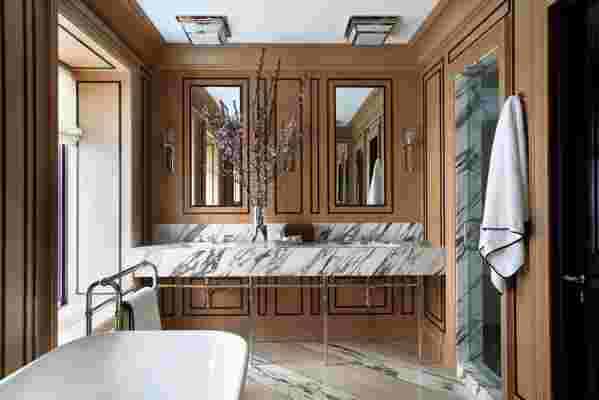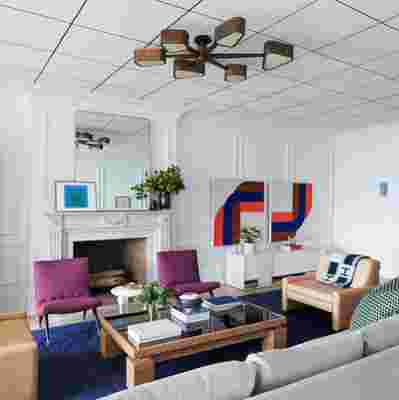In August 2017, the designer Summer Thornton posted a seemingly innocuous image of a tomato-red firehouse door on Instagram, citing it as inspiration for an upcoming kitchen project. But the picture set off alarm bells for at least one viewer. “I thought, ‘Oh boy, I hope that’s not for us,’” says Neil Heller, a friend and admittedly color-averse client who worked with Thornton on several projects (including his main residence two hours outside Chicago) before enlisting her to gut-renovate his three-bedroom pied-à-terre in a historic building on that city’s Gold Coast. Spoiler alert: It was.
“Summer is color and pattern to the max, which is completely opposite from me,” Heller says, recalling the trepidation that he quickly quashed. “We joked that I wasn’t her ideal client, but I went into this process with a really open mind. I knew that if I put my trust in her and let her do her thing, we would end up with something spectacular.” Adds Thornton, “We always like to try something we’ve never done before, but I also know [Neil] really well. I wasn’t going to push something that he wasn’t going to go for.”

In the master bath, Thornton juxtaposed diagonal swaths of Calacatta Monet marble with Breccia stone to distract from the room’s asymmetrical layout while providing a unique take on tradition, highlighted by the Waterworks fixtures and a freestanding tub by Ann Sacks. The oak paneling was detailed with black molding, a reference to the hand-painted ceiling in the living room.
So the usually very involved Heller and wife Jen Burge Heller took a hands-off approach, allowing Thornton to structurally recast the space to better suit the needs of a growing family. After combining two units that hadn’t been touched since the 1960s, she expanded and moved the galley kitchen to the front of the apartment, replacing a small bedroom to maximize Lake Michigan views and installing a glass divider to provide a sense of separation while maintaining a connection with the adjacent living room. She and her team reworked the foyer layout, recreated original molding and replated existing hardware, and employed clever solutions like arched doorways and disappearing closets to hide unsightly steel beams and plumbing stacks.
But the homeowners also allowed Thornton to flex her now well-known aesthetic muscles, giving her free rein to embrace rather than restrain her wild side. In the foyer, she gave the building’s 1930s architecture a modern edge with horizontal fluting on the walls and a fresh take on the lobby’s black-and-white marble flooring. Yet the most impactful style choice appears in the kitchen, where she offset traditional oak cabinetry with lacquered oxblood panels and intricately veined Calacatta Viola marble countertops. “We were playing with the idea of Pop art, pairing a tame base with a hit of color,” says Thornton. “But we calmed the red way down so it doesn’t feel over the top. It almost falls away.”

Thornton and her team maintained the existing fireplace in the living room and recreated the original molding, albeit with a modern twist. She also custom-designed the media console with a fluting detail that reflects the horizontal fluting in the entry area. “I love the way the living room turned out,” says Thornton. “It’s different from what we usually do, but I love the boldness of the furnishings against the crisp white walls.”
Thornton’s unique approach to details didn’t end there. Hand-painted pinstripes on the ceiling in the living room relate to the painted molding in the master bath, while a hand-marbled paper provides an unexpected jolt on the ceiling in the plum-hued powder room. A foliage-laden Scalamandre wall covering in the Hellers’ son’s bedroom offers soft contrast to the crisp white edges on display throughout the rest of the apartment. And violet upholstery on the living room’s slipper chairs pick up on the plum veining that weaves its way around the kitchen countertops.
The ultimate resource for design industry professionals, brought to you by the editors of Architectural Digest

Though the boldness of the palette is a deviation from Heller’s masculine, minimalist leanings, he wouldn’t have it any other way. “I love our main house, but I didn’t want to repeat it for a weekend place. This is meant to be more fun, more feminine, and a little edgier because it’s in the city,” he says. “I never could have imagined this for us, but that’s what a good designer does. Sometimes it’s good to step outside of your comfort zone.”
